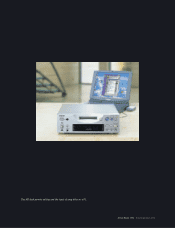Sony 1998 Annual Report Download - page 22
Download and view the complete annual report
Please find page 22 of the 1998 Sony annual report below. You can navigate through the pages in the report by either clicking on the pages listed below, or by using the keyword search tool below to find specific information within the annual report.[20] Sony Corporation Annual Report 1998
DVD-Video Players
Offering the outstanding functions, picture, and sound that take full advantage of the DVD
format, Sony’s new DVD-Video players performed well, especially in the United States. Making its
debut in Japan during the year was a DVD-Video player with a 5.1-channel DolbyTM digital
decoder. This system reproduces extremely realistic sounds.
Digital Still Cameras
Backed by rising use of PCs worldwide, the digital still camera market has been expanding
rapidly. By storing photos on 3.5-inch floppy disks, Sony’s Digital Mavica allows easy transfer of
images to a PC. This feature has led to brisk sales worldwide. In addition to the Digital Mavica,
Sony’s expanding digital still camera lineup also includes the Cybershot, which employs flash
memory to offer compact dimensions and light weight, and the MD Cybershot, which records
photos on a MiniDisc.
Broadcast- and Professional-Use Video Equipment
An overwhelming number of broadcasters throughout the world depend on Sony’s Betacam
format. More than 100 million Betacam-format analog and digital cassette tapes store invalu-
able video programming. As the world’s preeminent name in broadcast- and professional-use
video equipment, Sony is firmly committed to introducing digital products and systems that can
utilize these video resources.
During the year, Digital Betacam equipment deliveries were brisk to broadcasters and pro-
duction studios alike. In the news production field, Sony introduced a new field editing system.
The system is a new member of the Betacam SX series, which was unveiled in late 1996. The
editing system enables rapid editing of news recordings at the scene and allows system separa-
tion for added convenience.
In 1998, U.S. terrestrial TV stations plan to begin digital broadcasts. In response, Sony has
developed high-definition (HD) format broadcasting systems, which offer superb picture quality.
Based on the MPEG world concept, Sony added a new lineup of high-resolution video server
systems that use the industry-standard MPEG2 digital video compression technology. Sony dis-
played these new products and other systems including Betacam SX equipment based on MPEG2
technology at the April 1998 National Association of Broadcasters (NAB) Show in Las Vegas.
Sony also displayed DVCAM equipment that offers playback compatibility with the consumer-use
DV format. In addition to winning excellent reviews from many broadcasters worldwide, Sony
equipment earned many large-scale orders at the NAB Show.
« Televisions »
Color TVs
Sony’s Wega home-use color TVs with the industry’s first flat-surface cathode ray tube (CRT)
have been a huge success in Japan ever since the first model was put on sale in December 1996.
The Wega series has contributed to growth in Sony’s TV sales and market share in Japan. Sony
introduced these TVs in Europe and Asia during the year, generating an extremely favorable
response. Sony is promoting these models worldwide, including a model that can receive digital
terrestrial broadcasts in the United States, which are scheduled to begin in 1998.
The top-of-the-line Wega model launched in Japan during the year incorporates Sony’s new
Digital Reality Creation technology. Taking advantage of a unique Sony digital signal processing
algorithm, this technology creates an image from standard NTSC TV signals with twice the
density of vertical and horizontal lines, thereby yielding an even higher quality picture.
Moving closer to markets is a key strategy of Sony’s manufacturing activities. In line with
this policy, Sony started production of color TVs in Slovakia in October 1997. In response to
expansion of the Wega series, production capacity of FD Trinitron CRTs, which have flat-surfaces,
will be expanded in the United States, Europe, and Asia.
Projection TVs and Professional-Use Projectors
Achieving efficient use of space thanks to their slimness, projection TVs are enjoying growing
demand for use in home theaters, mainly in the United States. Sony differentiates itself from
























